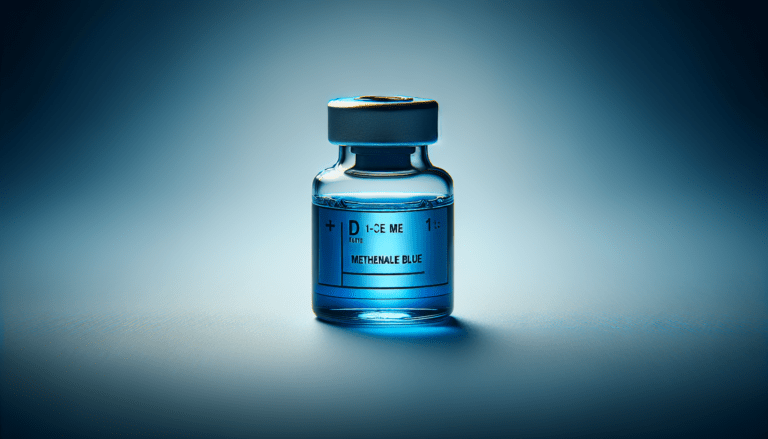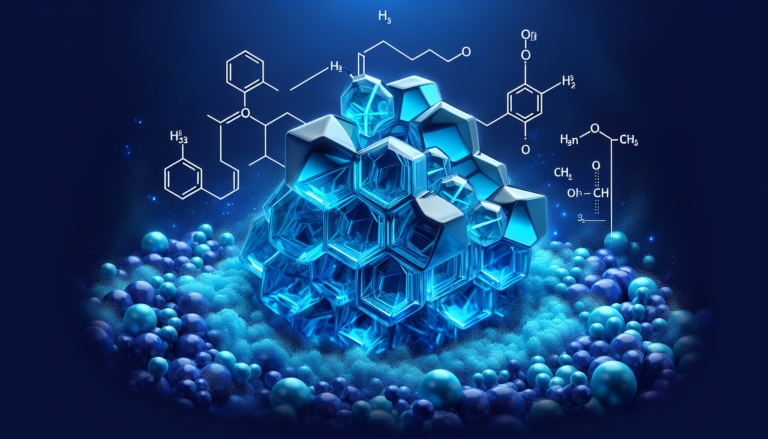Usp Methylene Blue
Imagine finding a versatile compound that offers a plethora of benefits for your health and well-being. Look no further than USP Methylene Blue, a remarkable substance with diverse applications. This article will provide you with an insightful overview of the incredible benefits that this compound has to offer. From its potential uses in medicine to its powerful antioxidant properties, USP Methylene Blue holds the potential to revolutionize various industries and improve countless lives. Get ready to explore the captivating world of USP Methylene Blue and uncover the exciting possibilities it brings.
Overview of USP Methylene Blue
Methylene Blue is a chemical compound that is classified as a medicinal dye. It is commonly used in various industries due to its unique properties and versatile applications. The USP (United States Pharmacopeia) standard for Methylene Blue ensures its purity and quality, making it suitable for use in pharmaceutical, medical, and research settings.
Definition and Purity Standards
USP Methylene Blue is a highly pure form of the compound that adheres to specific standards set by the United States Pharmacopeia. These standards ensure that the Methylene Blue used in various industries meets rigorous quality criteria, including purity, potency, and manufacturing processes. The USP guidelines guarantee that the Methylene Blue produced and sold meets the highest quality standards.
History and Development of USP Grade
The development of USP Methylene Blue can be traced back to the early 19th century when chemists discovered its distinct properties. Over the years, advancements in chemical synthesis and purification techniques have allowed for the manufacture of high-quality and pure Methylene Blue. The establishment of the USP standard for Methylene Blue further solidified its place as a reliable and recognized compound in the pharmaceutical and medical fields.
Applications in Various Industries
USP Methylene Blue finds applications in a wide range of industries due to its diverse properties. In the pharmaceutical industry, it is used as an active ingredient in medicinal products for the treatment of methemoglobinemia and other related conditions. In the medical field, Methylene Blue has antiseptic properties, making it useful in wound care and sterilization processes. It is also employed as a diagnostic tool in various medical procedures. Additionally, Methylene Blue plays a significant role in research, particularly in neuroscience, where it is used for innovative therapeutic studies and antimicrobial research.
Chemical Properties of Methylene Blue
Molecular Structure and Formula
Methylene Blue has a distinctive molecular structure consisting of a tricyclic phenothiazine ring system with methylamino substitution. Its chemical formula is C₁₆H₁₈ClN₃S, indicating the specific arrangement of carbon, hydrogen, chlorine, nitrogen, and sulfur atoms in its composition.
Physical Characteristics
USP Methylene Blue appears as a dark blue crystalline powder or dark blue-green granules. It is sparingly soluble in water but dissolves readily in alcohol and other organic solvents. The characteristic blue color of Methylene Blue is derived from its absorption and reflection of light in the visible spectrum.
Chemical Reactions and Stability
Methylene Blue is known for its ability to undergo various chemical reactions. It readily accepts and donates electrons, making it an effective electron acceptor and donor in redox reactions. It is stable under normal conditions but can degrade when exposed to light and oxidizing agents. Careful storage and handling are necessary to maintain the stability and efficacy of USP Methylene Blue.
Production of USP Methylene Blue
Manufacturing Process
The production of USP Methylene Blue involves a series of chemical synthesis and purification steps. The starting materials are subjected to controlled reactions, leading to the formation of Methylene Blue. These reactions are carefully monitored and optimized to ensure high yield and purity of the final product. Purification techniques, such as filtration and recrystallization, are employed to remove impurities and achieve the desired quality.
Quality Control Measures
During the production process, strict quality control measures are implemented to assess the purity, potency, and other quality attributes of USP Methylene Blue. Analytical techniques, such as spectrophotometry and chromatography, are utilized to evaluate the compound’s chemical composition and ensure compliance with the USP standards. Each batch of Methylene Blue undergoes rigorous testing to confirm its quality and consistency.
Regulatory Compliance
The production of USP Methylene Blue falls under regulatory oversight to ensure compliance with applicable guidelines and standards. Regulatory bodies, such as the Food and Drug Administration (FDA), set regulations to ensure the safety and efficacy of Methylene Blue for its intended applications. Compliance with these regulations is essential for the manufacturer to obtain the necessary certifications and approvals.
Pharmacological Actions of Methylene Blue
Mechanism of Action in the Body
Once administered, Methylene Blue exerts its pharmacological effects by various mechanisms of action. It acts as a redox agent, accepting and donating electrons in cellular processes. This property allows Methylene Blue to influence biochemical reactions involved in oxygenation processes, electron transport chain activity, and cellular metabolism.
Therapeutic Uses
USP Methylene Blue is primarily used therapeutically in the treatment of methemoglobinemia, a condition characterized by the abnormal increase in the amount of methemoglobin in the blood. Methylene Blue acts as a reducing agent, converting methemoglobin back to functional hemoglobin, thus restoring oxygen-carrying capacity in the blood. It is also utilized in the treatment of vasoplegic syndrome, a condition in which blood vessels lose their ability to constrict properly.
Off-Label Applications
In addition to its approved therapeutic uses, Methylene Blue has shown promising results in various off-label applications. It has been investigated for its potential role in treating neurodegenerative disorders, such as Alzheimer’s disease, by modulating neuronal activity and reducing oxidative stress. Methylene Blue has also been explored for its antimicrobial properties, potentially offering an alternative to traditional antibiotics in combating resistant bacterial strains.
Medical Uses of USP Methylene Blue
Use in Methemoglobinemia
Methemoglobinemia is a condition that occurs when there is an abnormal increase in methemoglobin levels, resulting in the reduced oxygen-carrying capacity of blood. USP Methylene Blue is the preferred treatment for methemoglobinemia as it directly converts methemoglobin to functional hemoglobin, restoring the ability of red blood cells to transport oxygen efficiently.
Antiseptic Properties
USP Methylene Blue possesses antiseptic properties, making it an effective agent for disinfection and wound care. Its ability to inhibit the growth of bacteria and fungi helps prevent infections in wounds and promotes faster healing. Methylene Blue can be used topically or as an ingredient in antiseptic solutions and dressings.
Diagnostic Utilization
Methylene Blue is widely utilized in diagnostic procedures in various medical specialties. In urology, it is used as a contrast agent during cystoscopy, aiding in the visualization of the urinary tract. Additionally, Methylene Blue is employed as a dye in ophthalmic procedures to assess tear flow and detect possible blockages. Its use as a diagnostic tool allows for accurate assessment and diagnosis of certain medical conditions.
Safety Profile of USP Methylene Blue
Toxicological Considerations
USP Methylene Blue is generally considered safe when used in accordance with approved guidelines and dosages. However, like any medication, it is essential to consider potential toxicological risks. High doses or inappropriate use of Methylene Blue can lead to adverse effects, including allergic reactions, hemolytic anemia, and serotonin syndrome. Proper medical supervision and adherence to recommended dosages are crucial to minimize the risk of such complications.
Contraindications and Precautions
There are certain contraindications and precautions to be observed when using USP Methylene Blue. It should not be administered to individuals with known hypersensitivity to the compound. Caution should also be exercised in patients with G6PD deficiency, as Methylene Blue can trigger hemolysis in such individuals. In pregnant or breastfeeding women, the use of Methylene Blue should be carefully evaluated, weighing the potential benefits against the risks.
Adverse Effects
While generally well-tolerated, USP Methylene Blue can cause some adverse effects. These may include gastrointestinal disturbances, dizziness, headache, and temporary discoloration of urine, stools, or mucous membranes. It is important to promptly report any unexpected or severe adverse effects to healthcare professionals for appropriate management.
USP Methylene Blue in Research
Innovative Therapeutic Research
Methylene Blue has garnered significant interest in innovative therapeutic research. Its unique pharmacological properties, including its ability to influence oxidative stress and cellular metabolism, make it a potential candidate for the treatment of various diseases. Ongoing studies are exploring its applications in neurodegenerative disorders, cancer therapy, and psychiatric conditions.
Role in Neuroscience
In the field of neuroscience, Methylene Blue has emerged as a valuable tool. It can modulate neuronal activity and improve cognitive function by enhancing mitochondrial function and reducing oxidative stress. These properties make it a potential candidate for the treatment of neurodegenerative disorders, such as Alzheimer’s disease and Parkinson’s disease.
Antimicrobial Studies
The rise of antibiotic resistance has prompted researchers to explore alternative antimicrobial agents, and Methylene Blue has shown promise in this area. Studies have demonstrated its effectiveness against a wide range of bacteria, including drug-resistant strains. Methylene Blue’s ability to disrupt bacterial biofilms and inhibit bacterial growth makes it a potential candidate for combating antimicrobial resistance.
Regulation and Standardization of USP Methylene Blue
USP Standards and Certification
The United States Pharmacopeia sets strict standards for the quality and purity of Methylene Blue used in various industries. The USP certification ensures that the Methylene Blue meets the defined criteria for identity, potency, stability, and other quality attributes. This certification provides reassurance to healthcare professionals, researchers, and consumers about the reliability and consistency of USP Methylene Blue.
FDA Oversight
The production, distribution, and use of USP Methylene Blue are subject to regulatory oversight by the Food and Drug Administration (FDA). The FDA ensures that the compound meets safety and efficacy standards, particularly in its approved medical applications. This oversight helps safeguard public health and ensures that Methylene Blue products on the market adhere to quality and safety regulations.
International Pharmacopeia Equivalents
In addition to the USP standard, other international pharmacopeias also define the quality and purity requirements for Methylene Blue. These equivalents, such as the European Pharmacopoeia, British Pharmacopoeia, and Japanese Pharmacopoeia, provide regulatory frameworks and guidelines for Methylene Blue production and use in their respective regions. Harmonization of standards across different pharmacopeias facilitates global consistency and interoperability.
Analytical Methods for USP Methylene Blue
Spectrophotometry Analysis
Spectrophotometry is a commonly used analytical technique to assess the quality and purity of USP Methylene Blue. It measures the absorption and transmission of light by the compound at specific wavelengths, providing information about its concentration and identity. Spectrophotometric analysis enables accurate and quantitative determination of Methylene Blue content in samples, ensuring compliance with USP standards.
Chromatography Techniques
Chromatography techniques, such as high-performance liquid chromatography (HPLC) and thin-layer chromatography (TLC), are employed for the analysis of USP Methylene Blue. These methods separate the individual components of a sample based on their differential affinities for the stationary and mobile phases. Chromatographic analysis allows for identification, quantification, and impurity profiling of Methylene Blue, ensuring its quality and purity.
Purity Testing and Impurity Profiling
To ensure the quality of USP Methylene Blue, purity testing and impurity profiling are conducted using various analytical methods. These tests assess the presence of impurities, such as related substances, by-products, or degradation products, which can impact the safety or efficacy of the compound. Purity testing and impurity profiling provide valuable information about the composition and integrity of USP Methylene Blue, aiding in its proper characterization and use.
Future Outlook of USP Methylene Blue
Advancements in Production Technology
The future of USP Methylene Blue lies in advancements in production technology. Continued research and development efforts aim to improve the manufacturing process, enhance yield, and optimize purification techniques to meet increasing demand. Advancements in production technology can lead to more cost-effective and sustainable methods for the production of high-quality Methylene Blue.
Potential New Medical Applications
Ongoing research into the pharmacological properties of Methylene Blue may uncover new medical applications. The compound’s ability to modulate oxidative stress, mitochondrial function, and cellular metabolism opens up possibilities for its use in the treatment of various diseases. Further exploration may reveal its potential in areas such as cancer therapy, neurology, infectious diseases, and regenerative medicine.
Implications of Regulatory Changes
The regulatory landscape surrounding Methylene Blue can impact its future outlook. Changes in regulations, safety guidelines, and pharmacopeia standards may influence its production, distribution, and use. Keeping abreast of regulatory developments and aligning with evolving best practices is essential for the continued success and advancement of USP Methylene Blue.
In conclusion, USP Methylene Blue is a highly versatile compound with a wide range of applications in pharmaceutical, medical, and research settings. Its chemical properties, production processes, pharmacological actions, medical uses, and regulatory aspects contribute to its significance and impact. Ongoing research and advancements in technology will continue to shape the future of USP Methylene Blue, paving the way for innovative medical applications and ensuring its continued quality and reliability.





